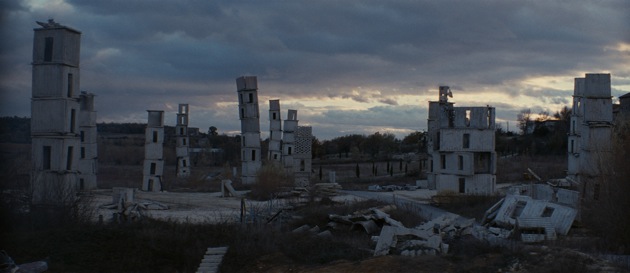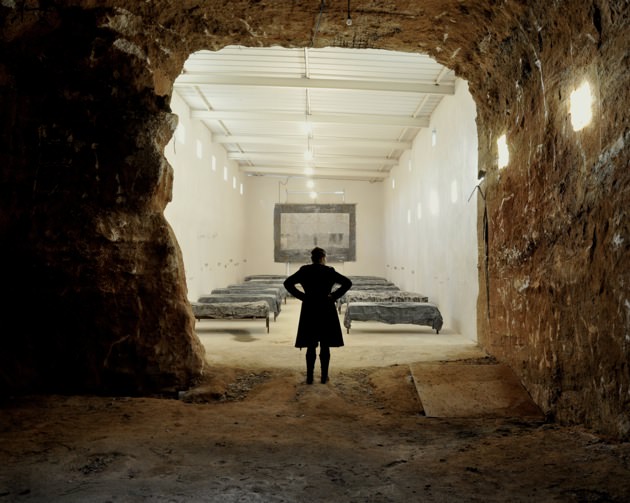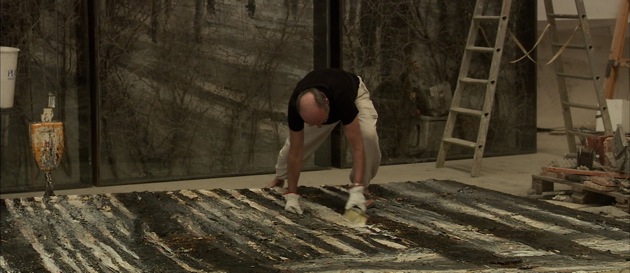Over Your Cities Grass Will Grow is a solemn, at times soporific, look at the work of the artist Anselm Kiefer, whose paintings and sculptures can be rather solemn to begin with. Directed by Sophie Fiennes, the movie is occasionally a documentary—when we see Kiefer doing an interview, or making his artworks with his studio assistants—but, devoid of narration, it is more often an art movie. For long, portentous stretches, no one is around. The camera merely takes in, accompanied by astringent music by György Ligeti and Jörg Widmann, the world of ruination that Kiefer has been creating in various buildings, set in fields and forests, in Barjac, in southern France, where he has lived since 1992.
For those of us who have admired, even been awed by, the work of the symbolically-minded German artist, simply seeing Kiefer in his studios, speaking with his assistants (in French), is fascinating. Bespectacled, trim, and not looking his sixty-five years, he isn’t a recluse, but in the three decades that he has been a world-renowned figure he has done a good job of staying out of the limelight. He came on the scene in the early 1980s with enormous landscapes and interior scenes that, whether of burnt-out fields or smoldering, empty, vast halls, suggested, with an unexpected lyrical and elegiac force, the devastation of modern German history.
Over the years, though, Kiefer’s work, continually summoning up Bible stories, wartime legends, and mystical awarenesses, has become woozily grandiloquent. He is an extraordinary showman, however. His pictures, where model ships or women’s frocks are often placed atop images of endless fields, the sea, or forests, can have a phenomenal physical presence. He is a master transformer of materials. From the first he made lead, steel, straw, glass, or crumbly clumps of cement with rebar sticking out bespeak fragility and delicacy. He has practically invented a sculptural form: a loose, disheveled pile of something, whether booklike shapes or plain detritus, placed flat on the gallery floor.
In recent years he has been creating sculptures that are in effect tottering, bunkerlike buildings. Fiennes’s movie shows that, moreover, Kiefer has been building a network of often rubble-strewn spaces. Her camera goes down one weather-exposed corridor after another. We see the artist or his helpers (sometimes on tractors) pushing earth around, digging holes, pouring cement, breaking panes of glass, and burning piles of books. The Barjac site, which includes little buildings, underground passageways, depots that seem to double as walk-in sculptural environments—and a number of the artist’s own huge studios—is, however, irritatingly hard to encompass. How vast is it? How do these buildings relate to one another? The film, unfortunately, is loath to look at itself as a giver of plain information.
A viewer assumes that one day visitors will make pilgrimages to Barjac much the way they now go to the Chinati Foundation, in Marfa, Texas, to see the work of Donald Judd and the art he collected, set out in the many buildings he purchased there over the years. Barjac is the un-Marfa. Where Marfa is about clarity of light, distinct artistic accomplishments kept rigorously in order, and a sense of the past as manageable and containable, Barjac is a setting of dust, dirt, dangerous shards of glass, tenuousness, relics, and symbols to be deciphered.
In thrall to loss, literature, and the past, Kiefer has something in common with the American painter Cy Twombly, who died in July, at eighty-three. His works also seduce us with their gracefully distressed surfaces. And both artists—who will scrawl phrases or titles onto their pictures in a similarly stylish, scratchy hand—make me restless with what feels like a too-easily-achieved beauty. Although it doesn’t sum him up, Twombly’s art evokes the lost classical, Mediterranean world (he was based in Rome from 1957). Kiefer’s art often takes us to the charred, stained German past. One believes with both that something is unearned, that what we look at is vaguely illustrational: a grafting of literary, political, or historical associations onto bravura manipulations of materials. These artists, at times heroic in their achievements, can also make the beautiful feel like the pretty.
Over Your Cities Grass Will Grow is playing at The Film Forum in New York City through August 23rd.





